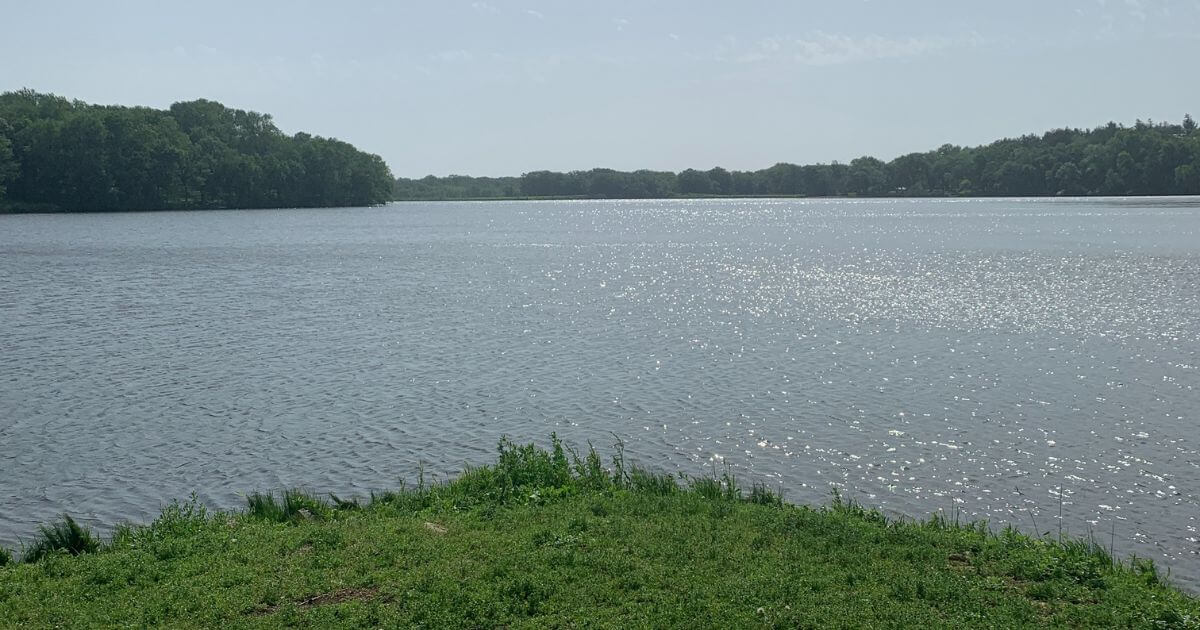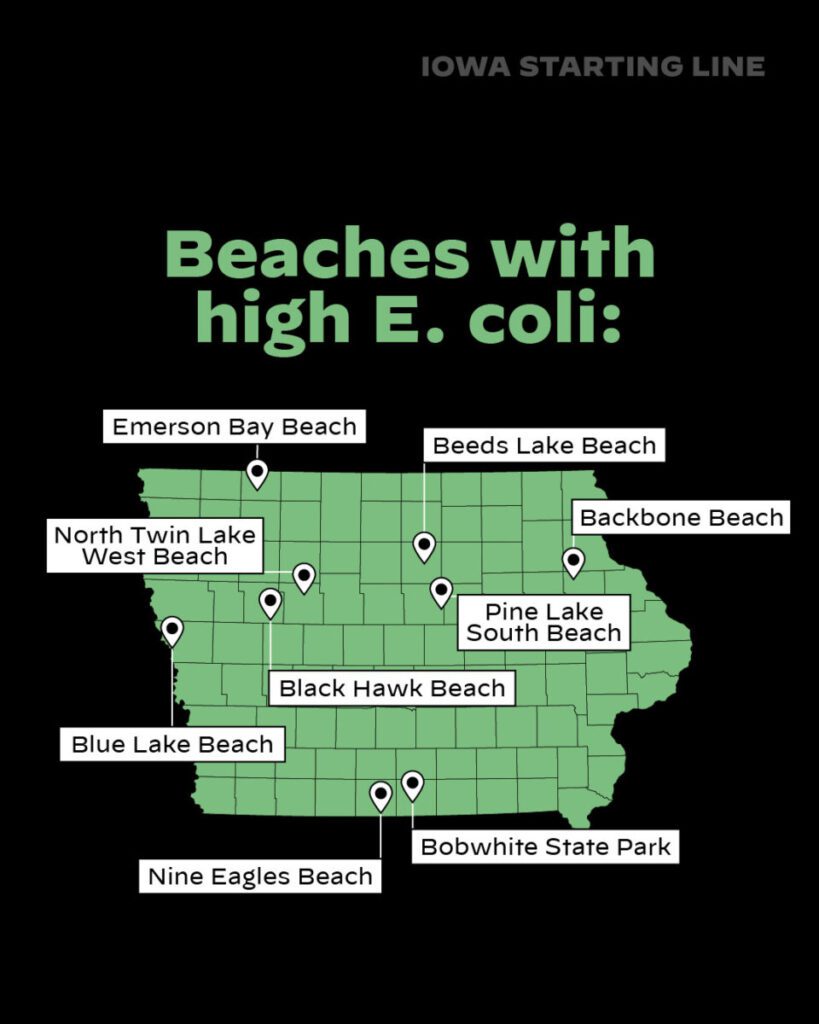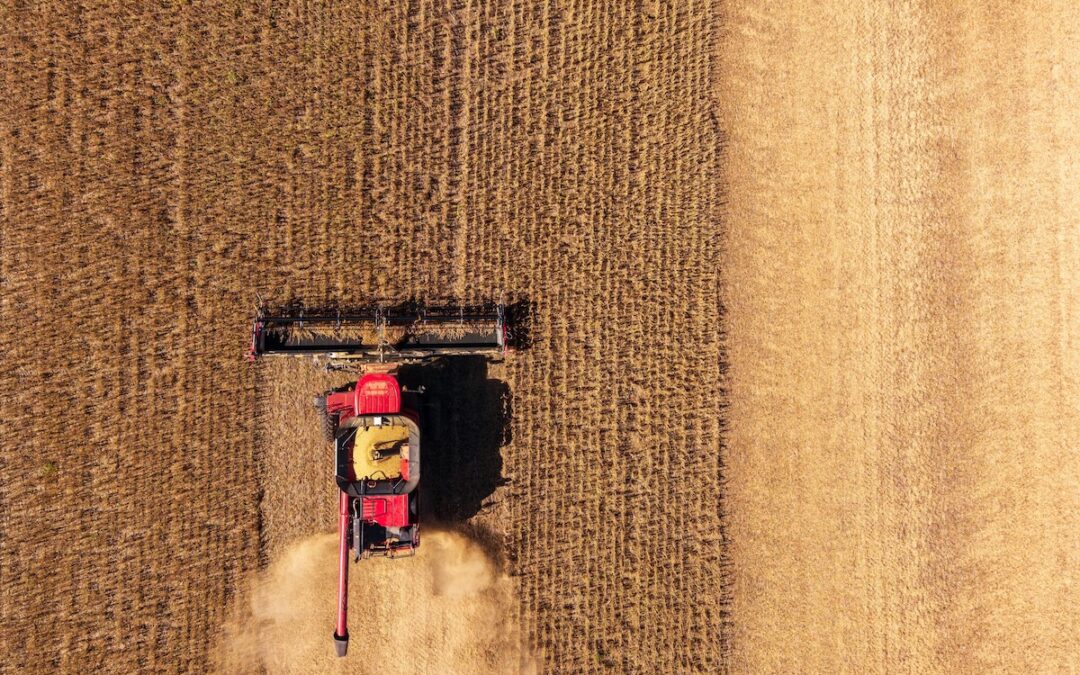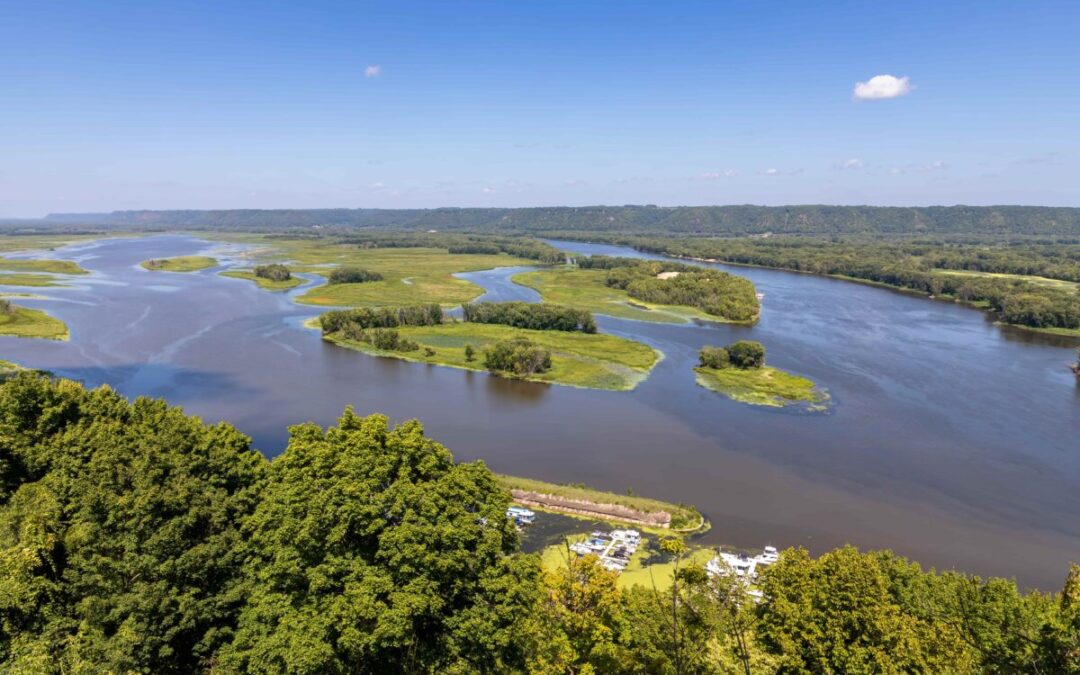
The view at Beads Lake State Park. (Photo by Amie Rivers)
This story first appeared in the July 29 edition of the Iowa Starting Line newsletter. Subscribe to our newsletter to get an exclusive first look at a new story each Tuesday in our The Hot Spot: Investigating Cancer in Iowa series.
Iowa’s rising cancer rate has many causes. Our worsening water quality is one.
Julie Russell-Steuart fondly remembers swimming at George Wyth State Park in Waterloo.
“I didn’t worry about the water quality” back then, when she was a teenager, she said. “I was more concerned about my swimsuit and laying out and trying to get a tan.”
At the beach on Memorial Day, however, Russell-Steuart didn’t bring her swimsuit. As a volunteer for the 48 Lakes Initiative for the Driftless Water Defenders, she only planned to get close enough to stick a testing strip into the water.
“I honestly haven’t really swum recently because I’m worried about the water quality here,” she told me, looking out at the water. “Every summer, we see on the news that, ‘Oh no, this beach is closed. You can’t swim here because there’s poop in it.’ You know, that’s what E. coli bacteria means.”

Julie Russell-Steuart, a volunteer with the Driftless Water Defenders, dips a nitrate test strip into the swimming beach at George Wyth State Park in Waterloo, Iowa, on May 26, 2025. The DWD tested recreational water as part of its 48 Lakes Initiative on Memorial Day to highlight Iowa’s worsening water quality. (Amie Rivers)
George Wyth is routinely on the list of state park beaches with “do not swim” advisories, which the Iowa Department of Natural Resources publishes each summer. Usually, George Wyth gets flagged for high levels of E. coli, which local officials blame on a combination of poor drainage and the resident goose population (though birds sometimes unfairly get blamed).
But many of the state’s other beaches face a different, more widespread issue: Upstream waste from large animal operations and runoff from nitrogen fertilizer—applied in increasing amounts to farm fields—are contributing to record nitrate levels seeping into Iowa’s rivers, lakes, and streams.
Forget swimming, then: What’s that doing to our drinking water? And what’s that got to do with Iowa’s cancer rates?
Central Iowa water of particular concern
Various groups across the state, including Prairie Rivers of Iowa, regularly test Iowa’s waterways. Results lately haven’t been good.
“Not only was nitrate in the Skunk River and Raccoon River higher than we’ve seen in a decade, the water in most creeks was chocolate brown with sediment and had E. coli counts in the thousands,” Dan Haug wrote in a Prairie Rivers blog post after a testing event in May.
Those two rivers were also the focus of the Central Iowa Source Water Report, a two-year study undertaken by Polk County that wrapped up this summer. It noted “poor source-water quality” along with “heightened demand” were putting a strain on drinking water for people living in the area.
The culprit? Ag pollution.
The report listed many threats to Central Iowa’s drinking water, including harmful algal blooms and toxins, along with PFAS, also known as “forever chemicals,” and pesticides. But nitrates were of particular concern.
“The Rivers often contain some of the highest nitrate levels in the US,” the report said, far higher than the safe drinking water standard. “Emergent research suggests ingesting levels of nitrate even below the current drinking water standard can pose health risks.”
How bad water contributes to cancer
High nitrates don’t just lead to more E. coli in lakes—they can also affect our bodies, causing a wide variety of gastrointestinal issues.
But there’s an even more insidious concern: Cancer.
Studies have shown that people who ingest consume nitrates in their drinking water, especially alongside a higher intake of meat, face increased risks of colon, kidney, and stomach cancers. There’s also some evidence linking higher nitrate intake to a greater risk of thyroid cancer and ovarian cancer in women.
The risks are even greater for Black Iowans and people who live near factory farms (known as concentrated animal feeding operations or CAFOs) and row cropping operations.
In other words, living in Iowa’s rural areas carries as high of a cancer risk as smoking. Poor water quality, therefore, is a major contributor to Iowa having the nation’s second-highest rate of new cancer cases for the second year in a row, per the Iowa Cancer Registry.
What’s being done?
Des Moines Water Works is charged with turning this nitrate-laden water into something the Environmental Protection Agency deems safe enough for human consumption. In 1990, they built a special nitrate removal facility to run on an as-needed basis.
The catch: It only has capacity for about an eighth of the water Des Moines needs.
After days of extremely high nitrate readings from both rivers in early summer, Water Works started asking people to voluntarily stop watering their lawns. On June 12, they banned it entirely.
The ban lasted for a month. In fact, as of this writing, Iowa’s largest metro area is still on a partial watering ban.
Water Works officials said they hope to solve the problem with two new cleaning facilities at a cost of $344 million, borne by taxpayers.
“It’s time we call that $344 million what it really is: One more government subsidy for Iowa Agriculture,” said Chris Jones on his Substack.
‘It’s going to take laws’
Jones knows the scale of the problem because he’s studied it his whole life. With degrees in both biology and chemistry, he understands the science. He worked as a lab scientist at Des Moines Water Works, so he knows how it affects our drinking water. And as an environmental scientist with the Iowa Soybean Association, he saw firsthand how agriculture has contributed.
He even wrote the definitive book on Iowa’s water quality problem, “The Swine Republic,” in 2023. Its conclusion was similar to Polk County’s recent water report: Iowa’s increased agriculture production, CAFOs, and decreased crop diversity (we either grow corn or beans) is all taking a heavy toll on Iowa’s environment.
Jones started Driftless Water Defenders in May of 2024 “to confront head on industrialized agriculture’s assault on our water resources” in Northeast Iowa, and now statewide.
“It’s important for people to understand that this is a colossal problem,” Jones told Iowa Starting Line. “We only have 3.3% of the land in the Missouri River basin, Iowa does, and we contribute 55% of the nitrate.”
Voluntary conservation over regulation—favored by Iowa’s elected officials at lobbyists’ insistence—clearly isn’t working, he said. Problems like what Water Works is experiencing are getting worse, in fact.
“That’s the one thing I try to impress upon people,” he said. “When you’ve got a problem of this scale, individual actions are not going to cut the mustard. It’s going to take government policy. It’s going to take laws.”

In June, state officials warned testing revealed high levels of e. coli at these 9 Iowa beaches.
Politicians aren’t interested
The federal government has tried to take action to address the state’s water issues, but the Iowa Department of Natural Resources pushed back. Critics say the DNR has failed to step up. For example, while the DNR has the power to fine polluters, particularly when egregious events like massive fish kills happen, Jones said the fines are “deliberately” low—if they’re issued at all.
“The ethic driving Iowa agriculture is one of exploitation,” he wrote. “Farm it all. Squeeze out every last bushel. Environmental degradation and other collateral damage like cancer, asthma, birth defects—that’s for sissies. They tell us it’s a small price we all have to pay for the prosperity they bestow upon us.”
The Iowa Legislature, dominated by Republicans for nearly a decade, has passed no new regulations to try and shore up water quality, content with the voluntary Nutrient Reduction Strategy that Gazette columnist Todd Dorman points out hasn’t done anything to improve things for its 13 years of existence. Meanwhile, Gov. Kim Reynolds prefers to pivot, blaming increased nitrates on drought and rain cycles.
Iowa’s congressional senators and representatives, all Republicans, cheered rolling back protections for Iowa’s few remaining wetlands, which the Iowa Environmental Council points out is a vital resource that helps filter groundwater—and groundwater is used for drinking water in many of Iowa’s rural areas.
“When these ecosystems disappear, groundwater supply wells often struggle to produce enough safe drinking water for residents,” the group wrote in a letter opposing it.
And President Trump has axed research attempting to decrease our reliance on nitrogen fertilizer, among many other federal science and research cuts.
In short: Nobody who leads our state or has the power to influence our political leaders appears to want to do anything about the problem.
“We subsidize row crop agriculture through a variety of means and animal agriculture through our tax dollars. Then, we’re also asked to spend our tax dollars to clean up the pollution,” Jones said. “It’s just stupid. You cannot find another example of this throughout the US economy.”
What you can do
Not every watershed has high nitrates. You can test your own drinking water and find out for yourself how high your nitrates are.
Drinking water tests: Iowa Starting Line is offering free nitrate test strips to readers who request one through this form. We only ask that you take a photo or video of your drinking water reading, and share that with us along with your city.
Recreational water tests: Request one from The Izaak Walton League, who will send you a free kit if you take a Nitrate Watch pledge (and according to their nitrate map, Iowans in particular have been taking advantage of this service).
You can also lobby your elected representatives to do something about it.
“Who’s benefiting? Well, of course it’s the big corporations and the oligarchs,” Jones said. “And we end up suffering from the pollution.”
READ MORE: What is behind Iowa’s cancer crisis?
Support Our Cause
Thank you for taking the time to read our work. Before you go, we hope you'll consider supporting our values-driven journalism, which has always strived to make clear what's really at stake for Iowans and our future.
Since day one, our goal here at Iowa Starting Line has always been to empower people across the state with fact-based news and information. We believe that when people are armed with knowledge about what's happening in their local, state, and federal governments—including who is working on their behalf and who is actively trying to block efforts aimed at improving the daily lives of Iowan families—they will be inspired to become civically engaged.


Davenport restaurant feeding federal workers for free amid government shutdown
The only qualifier a federal employee has to meet to eat free at Flavors of India is to show a work badge to verify their employment. Flavors of...

Big harvest no comfort to Iowa farmers, who worry about another Farm Crisis
President Donald Trump is expected to announce soon that his administration will send billions of dollars in assistance to farmers. As Iowa and...

Report: Nitrate levels toxic to Iowa water
By Mark Moran New data from the National Library of Medicine show nitrates in Iowa's waterways reached toxic levels earlier than...

This quirky Des Moines home up for sale features a working fire pole
Built by a well-respected local architect as their personal residence, a quirky home for sale in the Lower Beaver neighborhood hides a very unusual...

The Social Security Administration is no longer issuing paper checks. Here’s what you need to know
The Social Security Administration (SSA) has switched to electronic forms of payment. Here’s how you can set up your automatic payments with ease....

Iowa City ‘Free Speech’ rally highlights state’s legacy in First Amendment battles
Iowa has long stood at the intersection of First Amendment battles. In 1938, Des Moines Public Library Director Forrest Spaulding penned the words...






